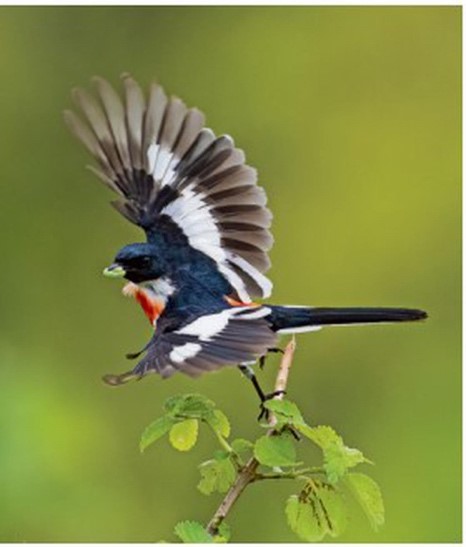
Disclaimer: Copyright infringement not intended.
Context
- The Zoological Survey of India's publication "75 Endemic Birds of India" sheds light on the significance of India's endemic bird species, accounting for 5% of the country's avian diversity.
Details
- 75 Endemic Birds of India provides details of bio-geographic regions where the species are found, their conservation status, historical relevance, differences in subspecies, distinguishing traits, and preferred habitats.
- India boasts an impressive 1,353 bird species, contributing to around 12.40% of global bird diversity.
- Endemic bird species are of paramount importance in the country's biodiversity, and their preservation is essential for maintaining ecosystem health and ecological balance.
Importance of Endemic Species in India's Biodiversity
Unique Adaptations and Ecological Significance
- Endemic birds exhibit specialized adaptations to distinct local environments, reflecting diverse ecosystems across India.
- Their presence serves as vital indicators of the health and functionality of various habitats and ecosystems.
- Preservation of these species ensures the continued functioning of intricate ecological relationships.
Contribution to Ecosystem Services
- Endemic bird species play crucial roles in pollination, seed dispersal, insect control, and natural pest regulation.
- For example, the Malabar Grey Hornbill, found in the Western Ghats, contributes to forest regeneration through seed dispersal.
- The Nicobar Megapode, endemic to the Nicobar Islands, plays a unique role in nesting behavior, burying its eggs to hatch through natural heat.
- Ensuring their survival supports essential ecosystem services that benefit both wildlife and human populations.
Conservation Status and Challenges Faced by Endemic Birds
Critically Endangered Species
Manipur Bush Quail (Perdicula manipurensis)
- Last Recorded Sighting: 1907
- Description: This quail species is small and elusive, with a unique bush-dwelling habitat in the Manipur region
- Threats: Habitat loss due to deforestation and agriculture are major concerns for this species.
Himalayan Quail (Ophrysia superciliosa)
- Last Recorded Sighting: 1876
- Description: The Himalayan Quail is a medium-sized bird known for its striking plumage. It was once found in the foothills of the Himalayas.
- Threats: Habitat destruction and hunting are believed to have contributed to its decline.
Jerdon's Courser (Rhinoptilus bitorquatus)
- Last Confirmed Sighting: 2009
- Description: Jerdon's Courser is a nocturnal bird with long legs and a distinctive double collar marking.
- Threats: Habitat loss and disturbance due to human activities have severely impacted its population.
Endangered, Vulnerable, and Near Threatened Species
- Several endemic birds are classified as 'Endangered,' 'Vulnerable,' or 'Near Threatened.'
- The Malabar Parakeet, found in the Western Ghats, is listed as 'Near Threatened,' primarily due to habitat loss and trapping for the pet trade.
- The Andaman Crake, found only in the Andaman Islands, is also classified as 'Near Threatened' due to habitat loss and disturbance.

The Role of Public Awareness and Education
Dissemination of Information through the Publication
- "75 Endemic Birds of India" aims to educate the general public, particularly students, about these unique species.
- Detailed information in the publication includes etymology, historical relevance, distinguishing traits, and preferred habitats.
- Increased awareness fosters a sense of responsibility and generates public support for conservation efforts.
Importance of Public Engagement
- Educating the public fosters appreciation for India's avian heritage and encourages responsible behavior towards wildlife and habitats.
- Students and youth can become future conservation leaders, contributing to long-term sustainability and awareness.
Enhancing Conservation Efforts
- Establishing Protected Areas and Habitats
- Creation and proper management of national parks and wildlife sanctuaries to safeguard critical bird habitats.
- Efforts to restore degraded habitats and establish ecological corridors to connect fragmented areas.
- Sustainable Development Practices
- Promoting sustainable land use and resource management that balances development and conservation needs.
- Engaging with local communities to implement eco-friendly practices.
- Involving Local Communities
- Collaborating with local stakeholders in decision-making processes and conservation initiatives.
- Providing economic incentives for communities to participate in conservation efforts.
- Responsible Ecotourism
- Promoting ethical birdwatching and nature tourism that minimizes disturbances to bird habitats.
- Generating economic benefits for local communities and conservation projects.
- Strengthening Research and Monitoring
- Conducting regular surveys to monitor population trends, distribution, and threats to endemic bird species.
- Utilizing scientific data to inform conservation strategies and adaptive management.
Zoological Survey of India
- The Zoological Survey of India (ZSI) is a premier scientific organization under the Ministry of Environment, Forest and Climate Change, Government of India.
- It was established in 1916 with the primary objective of surveying, exploring, and documenting the fauna of the Indian subcontinent.
- ZSI plays a crucial role in biodiversity research, conservation, and management, particularly in the field of zoology.
Key Functions of the Zoological Survey of India
- Faunal Surveys: ZSI conducts extensive field surveys and research across various ecosystems in India to document and study the diversity of animal species, including insects, birds, mammals, reptiles, and amphibians.
- Taxonomy and Classification: The organization is responsible for taxonomic research, describing new species, and updating the classification of existing ones. The accurate identification and classification of species are essential for understanding biodiversity.
- Endangered Species Conservation: ZSI plays a pivotal role in identifying and assessing the conservation status of endangered and threatened species, including endemic species, through the IUCN Red List.
- Biodiversity Monitoring: ZSI regularly monitors changes in species distribution, population trends, and habitat status to understand the impacts of human activities and climate change on biodiversity.
- Publication of Faunal Records: ZSI publishes comprehensive scientific literature, reports, and catalogs on the fauna of India, contributing to the knowledge base of the scientific community and conservationists.
- Wildlife Research and Management: The organization collaborates with various government and non-governmental agencies to conduct research on wildlife and recommend conservation strategies.
- Capacity Building and Training: ZSI actively engages in capacity building and training programs for students, researchers, and field personnel to enhance the understanding and conservation of biodiversity.

Conclusion
The publication "75 Endemic Birds of India" underscores the importance of conserving India's endemic bird species for ecological balance and biodiversity preservation. Public awareness and education are vital for garnering support for conservation initiatives. By involving local communities and implementing strategic conservation measures, India can safeguard its unique avian heritage for present and future generations. The preservation of endemic birds and their habitats contributes to the overall health and resilience of India's diverse ecosystems, reflecting the country's commitment to environmental stewardship and sustainable development.
|
PRACTICE QUESTION
Q. Analyze the importance of endemic bird species in India's biodiversity and ecosystem health. Discuss the challenges faced in conserving these species and propose effective strategies to safeguard India's unique avian heritage. (250 Words)
|
https://epaper.thehindu.com/ccidist-ws/th/th_delhi/issues/46754/OPS/GG0BJ7JMP.1.png?cropFromPage=true












